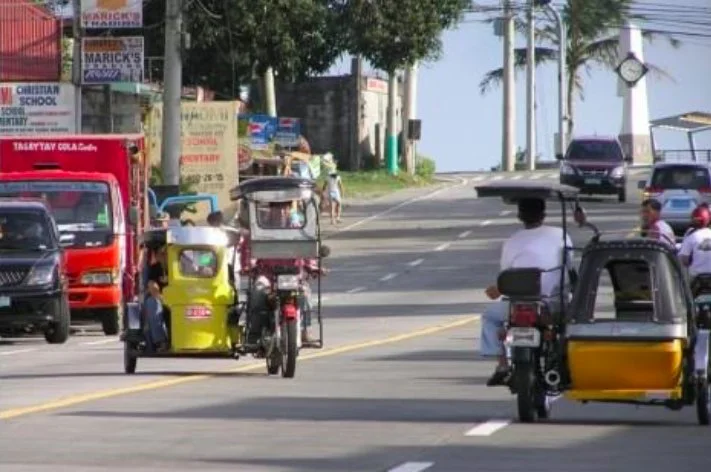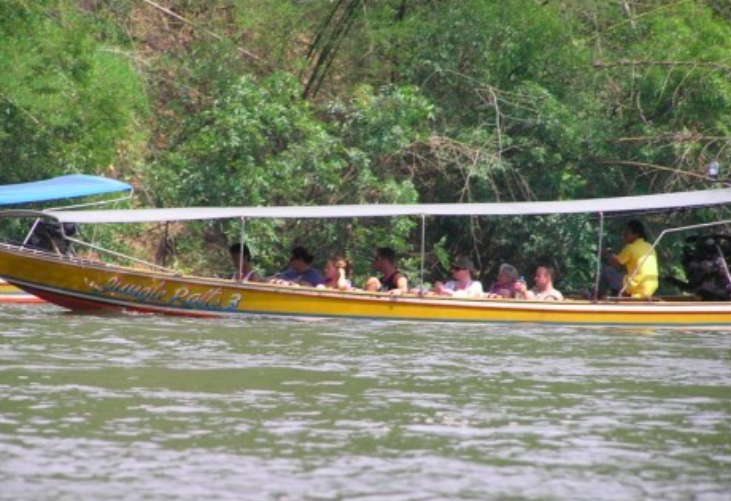Airplanes always feel like time machines to me. As soon you walk off the plane you feel the humidity or the heat, or cold of a new place in a different season. We knew we were in a different place when we disembarked in Bangkok - hot and humid. The international school had arranged for us to stay in a service apartment with much needed air condition.
We walk around to explore the neighbourhood a little bit, then take a taxi to downtown: it takes 40 minutes and 200 Baht - about 6 dollars.
Tuk-tuks in Thailand
The second we walk anywhere, we are bombarded by tuk-tuk drivers calling “Where are you going? Where are from? How long are you here? Where are you going tomorrow?” They even take the map out of our hands and proceed to tell us what we should see and do, where we should go, how much it will cost and how cheap their tuktuk is... Avoiding this becomes our goal and we walk with purpose. We walk into a market, hot and crowded and not what we wanted to see, but the palace grounds are closed due to a memorial service for a relative of the King who died many months ago. All Thais are dressed in black and white, buildings and gates draped with black and white garlands. Everywhere are photos of the royal family: on buildings, across bridges, along the main roads.
Gigantic photos of the royal family are everywhere.
Thailand is an interesting country. The current King’s father - King Bhumibol Adulyadej - was the ninth monarch of Thailand. Reigning since 1946, he was the world's longest-reigning head of state until his death in 2016. He was absolutely adored in Thailand, his portrait is everywhere with huge photo displays along major routes. His son, the current king is named Vajiralongkorn. If I understand my research correctly, his full, official name is Somdet Phra Boromma-orasathirat Chao Fa Maha Vajiralongkorn Bodindradebayavarangkun Sirikittayasombunsawangwat Worakhuttiyarajsantiwong Mahitalaphong Adulayadet Chakkrinaresyuppharajvisut Sayammakutratchakuman. Educated in the UK and Australia, he is one of the wealthiest monarchs in the world, with a net worth estimated to be between US$30 billion and US$70 billion. Interesting for a nation with such poverty.
A problem in Thailand is that the king likes dogs so much that they are protected by royal decree. No one is allowed to do anything about the millions of dogs running loose everywhere. Dogs sleep on every street corner, in front of every store, every where. I guess the one good thing about it is the dogs don’t appear on the restaurant’s menu. And if I were a dog, I’d want to live in Thailand, too. Many years ago, when the King was still Crown Prince, he had a white poodle named Foo Foo that was awarded a senior ranking in the Thai Royal Air Force….
We walk around Wat Pho: a huge complex of stupas, mosaics, roofs, a 151’ reclining golden Buddha. The roofs and mosaics and golden statues are amazing.
That night the teacher/librarian picks us up for dinner at a local Thai street cafe. We sit at wooden picnic tables, in long rows with only Thai people as the other patrons. They put a stone pot with fire in it, in front of us and bring a tea kettle with water. It’s a do-it-yourself dinner. A piece of fat sizzled on top of the dome over the fire. We pour water onto the dome, drop vegetables in the water to cook soup and then put pieces of chicken, fish and other meats onto the hot dome.
On Monday after school, Aree picks us up. She’s a professor from the University of Bangkok with whom I corresponded about the train library for my book My Librarian is a Camel. She takes us downtown to see the library train for ourselves. It is a refurbished old train, converted into a classroom and library for street kids. It was exciting to see this place in person, after writing about it for my book. Aree explains that the local police wants to encourage homeless kids to get an education. The police even teaches in the train cars to get to know the kids. They also helped them start a garden to grow vegetables.
After working at school for a week, we take a taxi for about an hour and a half, then a ferry for an hour and end up on Koh Si Chang, a small island off the coast of Thailand. The ferry was quite an experience: a small rusty vessel, loaded with vegetables, cartons of eggs and bags of dead chickens. People sat inside and out on long wooden benches. We crammed into the hold with our luggage, along with six monks, several old ladies and loads of stuff.
Kids were diving for coins of the ferry dock.
Koh Si Chang does not allow cars, only motorbikes and tuktuks. The hotel, called the Si Chang Palace, looked good online, but that turned out to be a bit deceptive: no internet, a pool with questionable water, but it does have air conditioning, a life saver for us. The website showed beach but there’s no beach to be seen, just a crowded street with little food stalls, lots of dogs and a rocky shore.
On my first morning off, on Koh Si Chang, I had planned to sleep in. But at 6 AM a long, loud prayer started on loudspeaker across town. At the first tone from the loudspeaker, dogs started howling. They howled in unison until every dog on the island was howling along.
We took a tuktuk to see the sights. First to the temple. A steep climb of hundreds of steps took us to the altar and several buildings with golden buddha’s, tables with dragons and burning incense. We bought a seashell for 5 Baht. It was very hot and we were dripping with sweat by the time we came back down.
Next the tuktuk took us to “the royal palace” - remnants and old buildings left from the time a previous King used this island as a retreat. Some buildings had statues inside, but mostly the site was in disrepair.
We enjoyed a meal of rice, noodles and fried chicken. And Heineken. Food in Thailand is great, especially the glass noodles.
Our hotel has an area that says “massage” but it doesn’t open until 12 AM so we are suspicious... There is almost no English here on signs and almost no one speaks English. We are not sure if our waitress in the restaurant is male or female.
Bang-Pa In Summer Palace
After our weekend away, we return to Bangkok to continue on to the next international school in Pattaya. We are, once again, treated like royalty. Our hotel room is large with floor to ceiling windows overlooking the very classy golf course. It’s the only time ever I’ve to school in a golf cart.
While I worked at the school, Kees and our son Arnout visited Koh Samet in the Gulf of Thailand. Koh means ‘island’. They found a wonderful little hotel right on a perfect beach. They swam and ate and enjoyed spending time together. At night they watched a fire dance demonstration on the beach.
Then it was off to Ayutthaya. This entire ancient city is a Unesco World Heritage site dating back to the King of Siam. Amazing ruins of temples and stupas, built from crumbling bricks. Elephants put on shows and we strolled around in the heat. Ayutthaya and its ruins is definitely a place worth visiting.
Next we board a bus for the river Kwai - famous of course from the book by Pierre Boulle, who was a POW here, and the movie. The bridge, which we walk across, is a regular cement pillar and steel railway bridge. Very touristy but interesting to see for ourselves.
We visit the war cemetery where many Dutch, Australian and other prisoners of war were laid to rest. 20,000 POW’s died while working on the railway to Burma, plus another 100,000 workers forced by the Japanese. The heat was so intense that we wondered how those people suffered while working on the railway. We took the Kanchanaburi train - along the Burma track - to tour the burial grounds. A sobering experience.
The best part came when we boarded a long boat from a pier near the bridge and proceeded up the river Kwai to the most wonderful spot we’ve ever stayed at! Twenty minutes upstream (at full speed) we found a floating hotel, a floatel. The rooms have teak wood floors and woven grass walls, and are latched together on rafts anchored on the shallow side of the river. Verandahs full of hanging plants in coconut shells and bamboo trays form a walkway along the rooms with grass roofs.
Floatel on the River Kwai
The restaurant jots out in front and bears the name ‘Jungle Raft Hotel’. It is so idyllic. We had a wonderful room with a kingsize bed and mosquito nets. There is no electricity at all in this eco-hotel, so no light and no air conditioning. But it cooled off much nicer here than in the city. Everything bopped gently on the river, ensuring a perfect sleep. It was nice to go unplugged and we listened to the silence of the jungle and the singing of crickets.
Our favourite pastime here was donning a lifejacket, walking to the far end of the rafts and jumping into the strong current of the river Kwai. With just the right amount of kicking, we landed at a ladder on the other end of the floatel, to climb back on and do it all over again. A refreshing, unique way to swim.
When the sun set, Kees and Arnout had a beer in the pub while I went for a wonderful foot massage. Halfway through an incredible storm hit. Lightning, rain, thunder and wind. The rafts were nearly torn from the shore. Palm leaves and debris flew everywhere. Even oil lamps fell and shattered. But the storm didn’t last long and things returned to normal - if you can call floating in the jungle on the river Kwai ‘normal’.
Being so close to the Equator, the time of sunset and sunrise doesn’t really change. A full moon added to the romantic feeling of our floating hotel. We slept under our mosquito nets, knowing that the hand sized spider in the leaf roof couldn’t (shouldn’t) reach us…
In the morning elephants came to bathe in the river. We walked to a Mon village just up the shore. The people here live in small thatched roof huts on stilts. They paint their faces with a white bark mixture to protect their skin from the sun. I’m told they are, originally, refugees from Mongolia. They make handicrafts to sell to tourists. Kees and I took a ride on the back of an elephant, which was much more meaningful here in the jungle, than on a parking lot in a city. We lumbered and swayed through a light bamboo forest, heard birds calling to each other, past a small Buddhist shrine and back to the village. There we saw the village school: a teacher with a small desk under a thatched roof, five or seven children at wooden desks and a blackboard hung between bamboo posts. No bookshelves, no sign of teaching resources. (Once we returned home we sent them lots of books).
We could easily have stayed longer at the river Kwai and vowed to return some day. But it was time for the long boats to take us back to ‘civilization’.
BOOKS - click, scroll down to Thailand
RESOURCES:
Ayutthaya: https://whc.unesco.org/en/list/576/
Koh Si Chang: https://www.tourismthailand.org/Attraction/ko-si-chang















